
Band Segmentation and Custom Sweeps. They’re expert settings available on some radar detectors that can significantly help improve a detector’s performance. However, if you set it up incorrectly, you may inadvertently prevent your radar detector from alerting you to legitimate police radar which… kinda defeats the whole purpose of having a radar detector in the first place. You can wind up getting tickets while thinking you’re protected. Additionally, different detectors implement this feature differently and the specific way you need to program it may even vary depending on where you live, so things can be a little confusing. The confusion combined with the risks of getting it wrong leads lots of people asking how they should program the detector they bought for the area that they live in.
Since this gets asked so frequently, I figured it’d be good to do an article going into all of this so that we have a solid reference to understand exactly what’s going on, what the benefits and risks are, and finally how to program the detector that you choose for the areas where you live and drive. (Note: This is applicable only for the US and Canada. The principles are the same everywhere, but the frequencies you need to scan for vary abroad.)
Outline of topics covered:
- Why Band Segmentation & Custom Sweeps?
- Ka False Alerts and RDR / Ka Guard
- Performance Test Results
- What Frequencies We Want to Scan For
- Out of Tune Guns
- The General Idea Behind Programming Your Detector
- Detailed Instructions for Segmenting Every Detector
- Cheat Sheet of Settings to Programming Every Detector
- Conclusion
Why Band Segmentation & Custom Sweeps?
So scanning X and K band is no big deal. They’re both a pretty small range of frequencies. Ka, on the other hand, is a wiiiiiide range of frequencies and so scanning across the entire range can take some time. X band is only 50 MHz wide. K band is 200 MHz. Ka band is 2600 MHz. Ka is more than 10 times as wide as both X and K band combined so it takes a lot more time to do an entire sweep of Ka band. (Note: The image below is not to scale.)

Because Ka is so wide, it’s sometimes referred to as Ka Superwide. It takes a few hundred milliseconds (few tenths of a second) to do an entire sweep of X, K, and KaSW. The detector does this sweep over and over and over again while it looks for police radar. If we can cut down on this time it takes to do one full sweep, we’ll improve the detector’s ability to catch brief alerts which means that it’s more likely to catch a very fast signal, whether it’s at close range or it’s the faintest whiff of radar way off in the distance, so speeding this scanning process up will help performance. It also makes a big difference when it comes to long distance range because of the faster scanning as well as because of some of the Ka filters (like RDR and Ka guard) that you can turn off at the same time. One way we can get this performance boost is to not scan the entirety of Ka band. We can sweep smaller sections of it.
Now here’s something pretty handy. While the police are authorized to transmit anywhere from 33.4 to 36.0 GHz, the manufacturers that produce police radar guns make equipment that only operates on a few small sections of that entire range of frequencies, 33.8, 34.7, & 35.5 GHz, +/- 100 MHz.

Aha! So knowing this, you can see what we’re getting at. We can tell our radar detectors to not bother wasting time scanning frequencies where police radar doesn’t even exist in the first place and only scan frequencies where it does. Cha-ching!
Ka False Alerts and RDR / Ka Guard
Now this has another benefit. There’s a feature called RDR in Escort products and Ka guard in the Valentine One. It’s a Ka band filter that’s designed to filter out false alerts from other poorly designed radar detectors nearby. You can read this article to learn the technical information of how it works. If you disable that filter, you’ll get a nice boost in performance at the cost of more false alerts.
With band segmentation and custom sweeps, we can turn off the frequencies where we’ll get only false alerts and that will help significantly reduce the falses that come with disabling RDR and Ka Guard. Nice.
The main reason for BS/RDR is to unlock the full potential of a detector’s performance. For example, prior to this update, the Redline was nicknamed “Sleeping Beauty” because it was so slow at waking up and alerting to the presence of police radar. Once it got the feature, the detector woke up from its slumber and became far more reactive and responsive. It’s now one of the fastest detectors around. Long distance range improved considerably as well. Here’s a test that was done with the Redline and V1 both got this feature and we wanted to see what difference it made. Check this out…
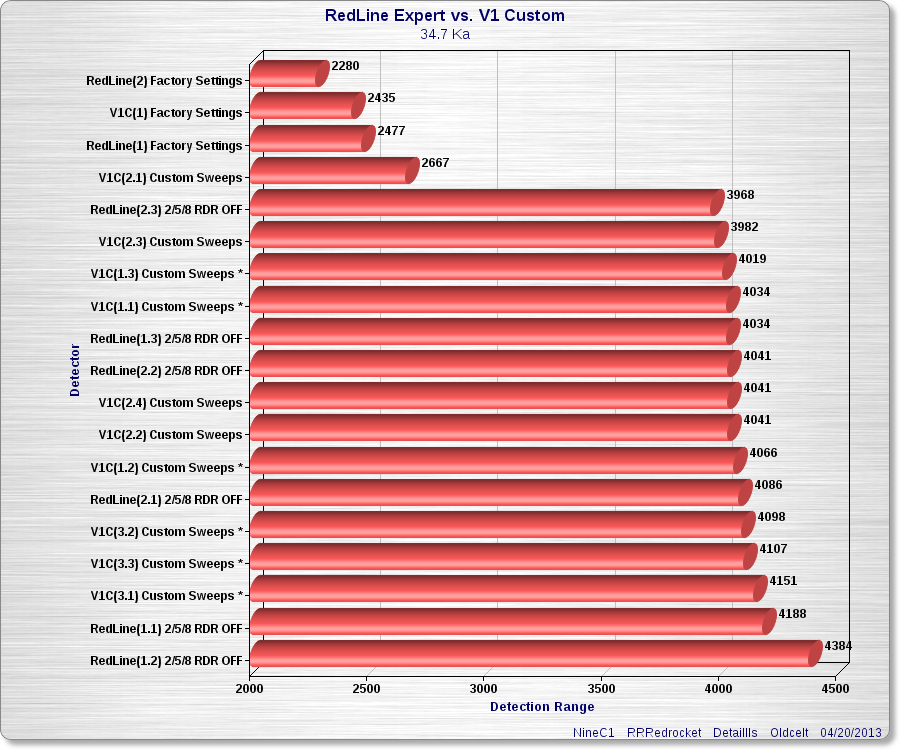
Source and complete test information: http://www.escortradarforum.com/forums/showthread.php?t=8095
Massive difference, isn’t there? On that particular course, range actually DOUBLED with BS/RDR!
Now this doesn’t mean that you’ll always see 2x the range with this feature. The exact range is highly dependent upon terrain and conditions, but you will see improvements either way. You can see additional testing here, here, and here on different courses by different testers with different radar guns and you’ll see improvements every time.
This should also help X and K band performance (assuming you’re not using TSR) since speeding up the detection speed benefits all bands.
What Frequencies We Want to Scan For
So as we’ve talked about, you can see that police radar only exists within 3 subsets of the entire Ka band range.
MPH brand guns are designed to operate at 33.8 GHz, +/- 100 MHz
Stalker brand guns are designed to operate at 34.7 GHz, +/- 100 MHz
Decatur and Kustom brand guns are designed to operate at 35.5 GHz, +/- 100 MHz
Therefore we generally want to focus our radar detectors in on these areas.
Now I say “designed to operate” because that’s the range where the radar guns should operate when they’re in spec, but sometimes guns will fall out of tune, particularly if they haven’t been calibrated for a while. Guns may drift high or low, outside the range they’re designed to. That doesn’t mean a 34.7 gun will suddenly start giving invalid readings or anything if it’s transmitting at 34.840, but from what I understand, it will start to impact the detection abilities and range of the gun. In any event, if you set up your detector to scan too narrow of a range of frequencies, you may get owned by an out of tune gun. That’s why it’s generally recommended to set sweeps a little wider than +/- 100. Running sweeps at +/- 150 or even 200 is common to account for out of tune guns.
Now out of tune guns are actually relatively rare. Apparently Stalkers are the most common brand to drift out of tune for whatever reason, but it may just be due to the popularity of those guns. Either way, based on people sharing their experiences around the country on RDF, the general consensus seems to be that it’s most common with Stalkers, though it is possible with any brand of radar gun.
Before Stalker settled on 34.7 as the frequency they chose to use for all their radar guns, they produced some guns that operated on other frequencies. The Stalker ATR, one of their older guns, is the classic example. Some of the them were designed to operate on 35.2, for example. The ATR is an older gun and most of them are starting to fall out of service and be replaced with newer guns, but there are still some in use here and there. For example, there is a 35.2 gun here in Washington State that @joehemi has encountered at least twice.
One of the ATR’s that I picked up on eBay also happened to be an off frequency gun. It transmits around 34.852. When I first got it, I thought it was just wildly out of tune. However, once I opened it up, I saw that it actually had 34.8 written on the horn itself which makes me think it’s actually designed to be a 34.8 gun. Either way, here’s a clip of me messing around with it when I just got it and checking out how my Redline, which was segmented 2/5/8 and thus doesn’t include 34.8, would stay silent while the gun was transmitting. (You can ignore the shots when I pointed the gun right at the Redline which overdrives the detector and makes it display incorrect frequencies. Anyways, check out the video.)
So this is an off frequency gun. It’s not exactly the same thing as an out of tune gun since it’s technically in tune for an atypical frequency, but it’s a good illustration of how a detector can miss an alert while a radar gun is clocking your speed.
Now I always hesitate a little bit when I share this sort of stuff because I don’t want to freak people out and have them panic and start to worry so I want to reiterate once again that this is very rare. That said, I’ve been keeping track of when people see any out of tune guns in use in different areas around the country and if you’d like to see what people are reporting in your area, simply check out this thread.
The General Idea Behind Programming Your Detector
It should be pretty clear by now, but the whole idea of programming your detector is to tell it to focus on scanning just 33.8, 34.7, and 35.5.

Different detectors have different ways of doing this with varying levels of control and ability, so let’s look at how to program different detectors to accomplish this, starting from the simplest ways and working up to the most advanced ways of doing it.
While not all 3 frequencies are in use in different areas, generally you’ll want to scan for all 3 anyways. Performance differences are pretty small when we talk about scanning 1 vs 2 vs 3 segments. We’ve already chopped out so much of the Ka range that the detector is gonna be nice and fast at this point. This way you get a fast detector that’s good for all 50 States. No matter where you drive, scanning for these frequencies will keep you covered. That said, some people do like to turn some of these bands off. You really need to know what you’re doing, of course, but if you want to turn off the 33.8 sweep, for example, because you’re absolutely sure it’s not in use in your area, you can get rid of all of the false alerts that you’ll get in that area that happen when you disable RDR.
If you’re not sure what’s in use in your area, just drive around with the detector set to display the frequency information and you’ll find out over time. You can also reference the RDFGS and see what other people have seen.
Programming Your Radar Detector
Radenso Pro & Pro SE, Beltronics RX65

These detectors have an option in the settings to simply turn this feature on and off which is the simplest method. On the RX65, you set it to USA Mode. With the Radensos, you change it from Ka Wide to Ka Narrow. I don’t know the specifics of the frequency range USA mode scans, but with Ka Narrow, you’ll be scanning 33.8, 34.7, 35.5 +/- 120 MHz.
Escort Passport, Escort Passport X70
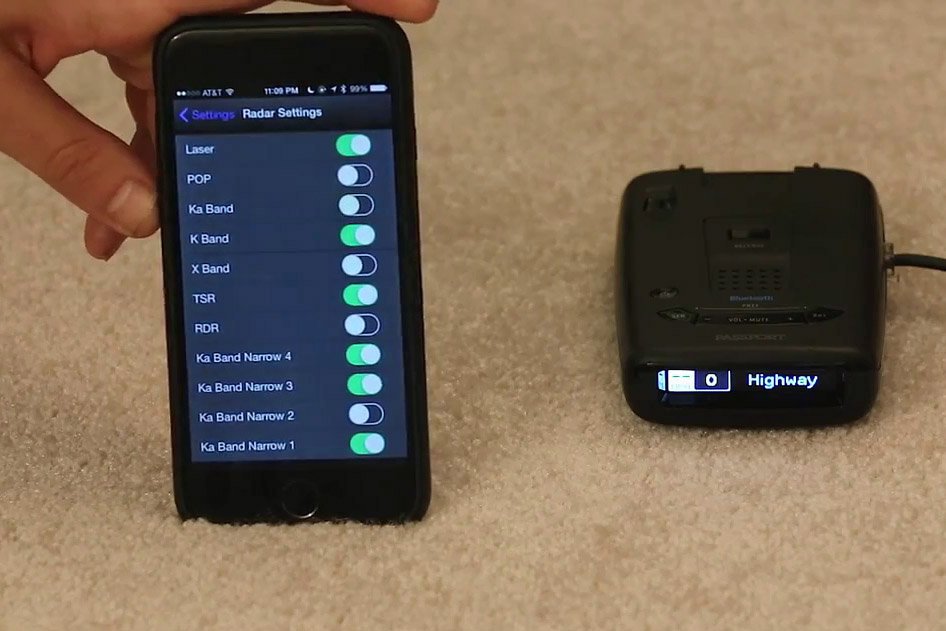
The Passport and Passport X70 give you more control over turning individual segments on/off with 4 individual segments.
- Ka 1: 33.660 – 33.900
- Ka 2: 34.200 – 34.400
- Ka 3: 34.600 – 34.800
- Ka 4: 35.400 – 35.600
So rather than turning everything on or off, you can pick and choose which segments you want, depending on what’s in use in your area. It also has 34.3 support which is used internationally.
You’ll want to disable Ka band first and then enable segments 1, 3, & 4 to get coverage for 33.8, 34.7, & 35.5 for the US.
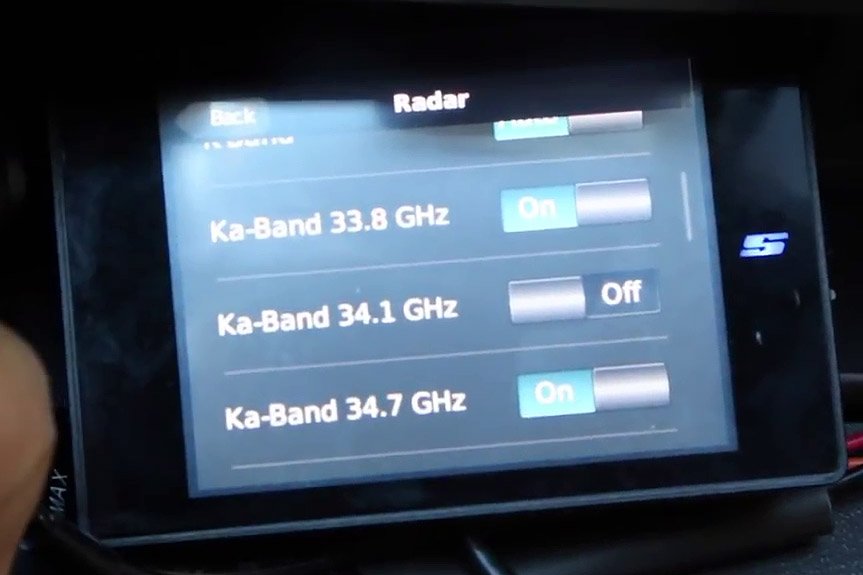
The Stinger VIP’s settings are very similar to the Passport’s.
Enable expert mode and then you have individual settings for 33.8, 34.1, 34.7, & 35.5. Simply enable the bands you need accordingly.
Escort Redline, Beltronics Magnum, Escort 9500ci, Beltronics STi-R & STi-R Plus
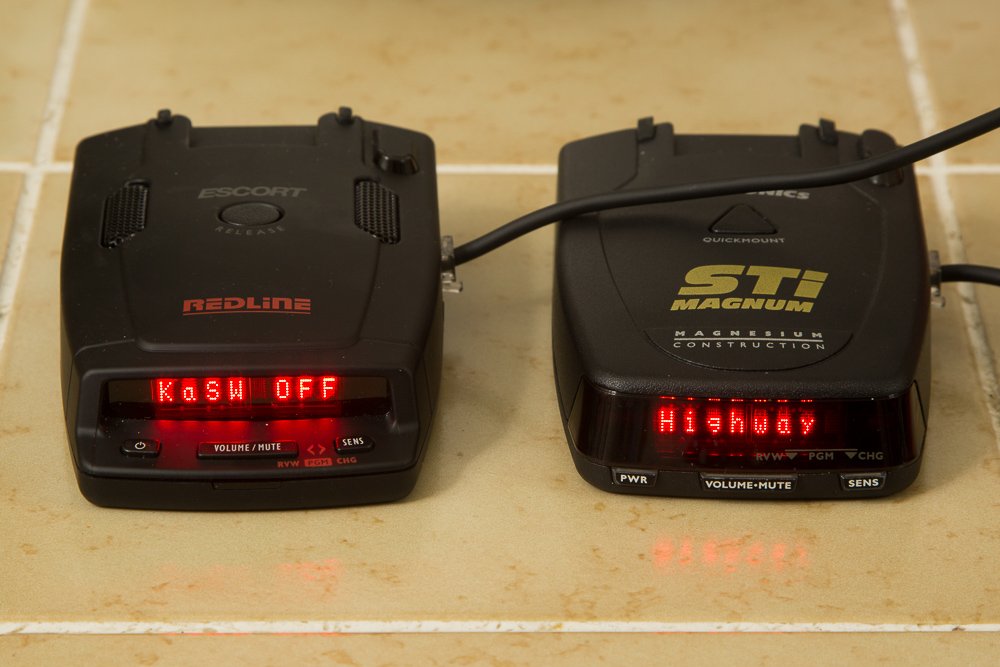
This is also similar to the Passport with giving you discreet segments you can turn on/off, but now you have segments that cover the entirety of Ka band. So if you want to do a wider sweep to cover out of tune guns, you can enable additional segments to cover you for the additional frequencies.
- Ka1 = 33.392 – 33.704
- Ka2 = 33.704 – 33.896 (33.8)
- Ka3 = 33.886 – 34.198
- Ka4 = 34.184 – 34.592
- Ka5 = 34.592 – 34.808 (34.7)
- Ka6 = 34.806 – 35.166
- Ka7 = 35.143 – 35.383
- Ka8 = 35.378 – 35.618 (35.5)
- Ka9 = 35.595 – 35.835
- Ka10 = 35.830 – 35.998
Most people just run 2,5,8 to cover the 3 main bands. Some people also enable 4 and 6 to give you additional coverage against 34.7 if they have a lot of Stalkers in their area. I’d advise against turning on too many bands though. It’s a balance. The more you turn on, the more you’ll start to reduce range. If you’re curious to see that in action, here’s a test that @hiddencam conducted. Check out what happens when additional bands are turned on and off @Pointercone’s Redline or when RDR is enabled or disabled.

Complete test results and discussion here: https://www.rdforum.org/showthread.php?t=30716
So as you can see, running 2,5,8 with RDR off offers the best performance. Turning another segment or two on is alright. Turning on a whole bunch of segments or enabling RDR really does start to reduce the performance back down.
Turning segment 1 off will help significantly with false alerts since that’s where you’ll see the majority of your Cobra falses. They’re often around 33.6xx’ish, +/-. They can happen in other frequencies too, but that’s the main one so it’s nice being able to turn off anything below 33.7. MPH guns tend to be pretty good at staying closer to 33.8 so it’s not a big risk to cut off your detector 100 MHz under 33.8.
To access the individual segments, make sure you disable KaSW in the detector first to open up the options to change the individual segments, otherwise you won’t see them available at all.
You’ll also need the latest expert firmware from Escort and Beltronics. It’s a free update. The Redline can be sent in for the upgrade or it can be upgraded via Escort Live. The Magnum has to be sent back to Beltronics for the free update. There’s no known timeframe for support for downloading the update via Escort Live. You can check to see if you have the latest firmware by seeing if you have an RDR option in the BandMOD settings, as well as if you have KaSW instead of just Ka.
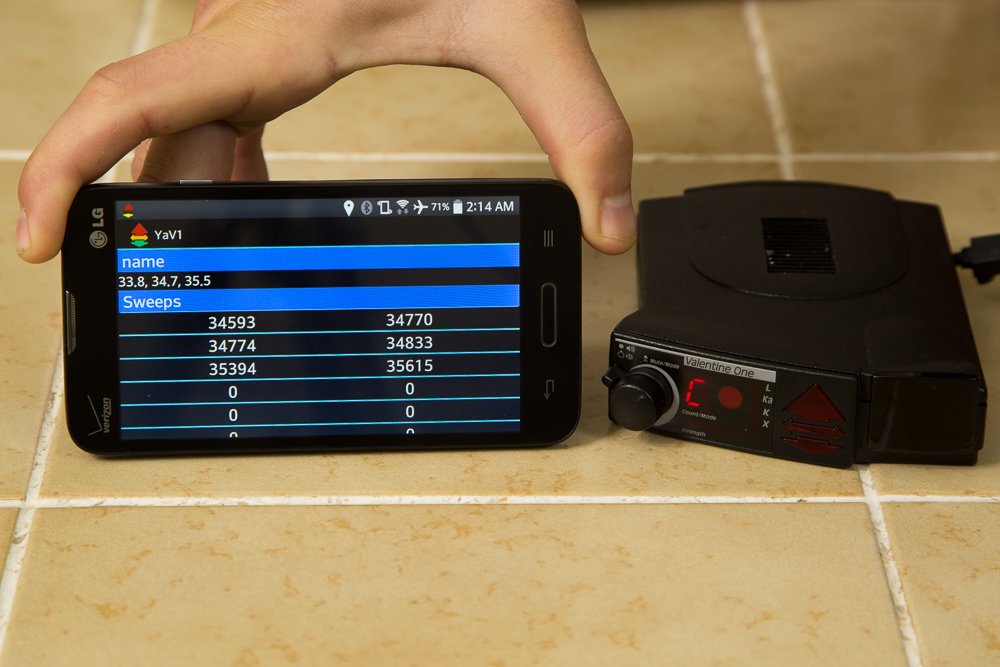
This one is a little bit different and a can be a little less intuitive than others. Rather than turning the feature on or off or having predefined segments to choose from, here you define exactly the sweep ranges you want to cover so you have more fine tuned control which is great. There’s also a couple weird things that you wouldn’t expect, so let’s talk about programming the V1 with your standard 33.8, 34.7, & 35.5 sweeps. You’ll need a V1 3.892 or newer to do this.

Notice anything strange in the sweeps above? 33.8 isn’t explicitly listed and 34.7 is broken up into two parts. What’s up with that?
33.8 you actually don’t have to sweep for to get it to work. I know it sounds a little weird, but the way the V1 sweeps, it has a unique way of scanning for 33.8 Ka POP shots without negatively impacting the performance of other bands so the 33.8 sweep is built into the V1 and actually can’t be disabled. Because it’s built in, you don’t have to create a 33.8 sweep to get it to work.
34.7 is also a little weird. The way the V1 does its sweeps, you have to break up the 34.7 sweep into two chunks. The first one goes up to 34.770 and the second one starts at 34.774. You can’t do one big sweep to encompass all of 34.7. Weird, I know. You’ll notice there’s also a gap of 4 MHz and that’s okay. The V1 oversweeps slightly according to VR so that gap of 34.770-34.774 will still be scanned despite the gap in the sweeps you’ve programmed.
35.5 is the only normal one, haha. Program in the range you want to scan and you’re set. Voilà!
Another quick note is that you can’t actually do something simple like 35.400-35.600 to make nice round numbers. You can type that in, but once you load the sweeps into the V1, they’ll get changed a bit. The V1 is kinda like the Redline in that it actually does have a bunch of individual discrete segments you can scan through. When you type in the frequency boundaries you want, it will pick the nearest one that it actually can use. So trying to select 35.400-35.600, for example, it’ll actually wind up setting it to 35.394-35.615 once you load it into the V1. That’s why you’ll see numbers that look a little strange.
You’ll also need to enable Euro mode (even if you’re not in Europe, haha) in order to program your custom sweeps. If you’re in A, l, or L mode, this won’t work. Enable Euro mode first which will display a ‘U’ on the V1, then you can load in custom sweeps and it will display a ‘C’.
Finally, you have room to load in 6 different sets of sweeps. Should you use those extra sweeps or leave them blank? I generally just leave them blank as you can see in the example above. Some people have experimented with fancier and more complicated sweeps, things like maybe scanning 34.7 repeatedly if it’s used heavily in the area they drive in with the idea that it tells the V1 to spend more time focusing on just that range as opposed to frequencies that aren’t as heavily used (such as maybe 33.8 which can’t be turned off), changing around the order of sweeps, etc. As far as I’m concerned, this all seems to just confuse people more than anything. I’m not convinced that this stuff has a big impact in performance and it’s never shown any consistent results in testing, especially considering that a custom swept V1 is the fastest and most reactive radar detector I’ve ever tested. The thing is absurdly fast and it’s virtually impossible to sneak a quick trigger shot past it. Nothing else out there can match a custom swept V1. Some detectors like the Redline are very close and are also lightning fast in real life and should have no problem in real life either. In any event, using custom sweeps on the V1, that makes big difference over stock settings. Trying to go with fancier sweeps to improve things further, I haven’t seen a benefit to doing that, but you will see people nonetheless testing a variety of different sweeps to see try and extract the maximum level of performance from their V1, custom tailor it to where they drive, and so forth.
What I recommend is a standard simple sweep to cover 33.8, 34,7, & 35.5 as depicted above. Maybe make them a little wider if you want. Some people will run the 34.7 sweep to cover 34.500-34.900 or so.That’s cool too. You’ll get coverage for out of tune guns at the risk of additional false alerts. Either way, a standard basic sweep to simply cover all the frequencies you need works great and that’s what I personally run and what I generally recommend.
Escort Passport Max, Max2, & Max360, Beltronics GT-7

This one I want to cover because it’s able to scan very quickly like detectors that rely on custom sweeps, except the Max doesn’t use it or need it to get its speed. Nevertheless, people have asked for the feature to be implemented in the detector anyways. As such, it would be good to talk about.
Back when the original Passport Max was being tested, it also had band segmentation. We could see that when the development units were sent to the FCC for certification and approval for sale here in the States and the manuals were posted online. When the production version of the detector came out, Escort removed the feature, saying that it was unnecessary for performance reasons since its scanning techniques are different and more sophisticated.
The Max detectors don’t need band segmentation for performance the way most traditional detectors do. Thanks to its DSP chip, it’s able to sweep the entire range of frequencies really quickly. Like ridiculously quickly. Because it’s so fast, it can actually do some fancier stuff like scan the entire range repeatedly and average all the scans together. Because noise is random but an actual signal is not, doing multiple scans and averaging them out means the noise floor will drop and the signal will stand out better above the noise, making it easier to pick out a weak signal within the noise and thereby giving us better sensitivity and thus range. Very cool. In any event, because it’s scanning so quickly, it doesn’t need band segmentation to make it fast the way other detectors do. Now technically it’s not quite as fast as a swept V1 or a segged Redline, but the differences are primarily academic and the Max should have no issue picking up very fast shots in real life.
Now even though the Max doesn’t need band segmentation for speed, enthusiasts have been asking Escort to implement this feature nonetheless, but Escort hasn’t done it. Why would people ask for it?
Well the Max and Max2 have long had issues with Ka false alerts showing up around the 33.6xx range. It arises in the presence of some K band sources where the Max incorrectly reports K band signals as Ka. This problem carried over from the Max to the Max2. With the Max360, Escort apparently attempted to fix it because the same sources that caused 33.6xx on the previous gen Maxes don’t on the 360. However, the 360 now has the same issue except that it reports signals at 33.4xx. It’s also done some 33.6xx here and there, but mostly 33.4xx. Either way, 33.4xx and 33.6xx is never ever legit. It’s always a false alert. If Escort is having trouble for whatever reason figuring out how to fix this bug, they could always just provide us with a bandaid and tell the detectors to just never alert to signals in those frequency ranges. They could also bring band segmentation back if not for performance reasons, but for false alert prevention reasons. It’s a very simple way to fix this bug, but it hasn’t been done. So if you see people asking about band segmentation on the Max, that’s why.
Summary of How to Enable Band Segmentation on various detectors:
Beltronics RX65:
USA Mode
Radenso Pro & Pro SE:
Ka Narrow
Stinger VIP:
Expert Mode, Enable 33.8, 34.7, & 35.5
Escort Passport & Passport X70:
KaSW off, RDR off, Segments 1,3,4 on
Escort Redline, Beltronics Magnum, Escort 9500ci, Beltronics STi-R & STi-R Plus
KaSW off, RDR off, Segments 2,5,8 (Running 2,4,5,6,8 is optional if 34.7 is heavily in use)
Valentine One:
Euro mode, Ka guard off, Sweep for 34.593 – 34.770, 34.774 – 34.833, 35.394 – 35.615. Wider sweeps to cover 34.500 – 34.900 instead are optional. You can use the preset built into YaV1 to do this for you.
Escort Passport Max, Max2, Max360:
Not available and not necessary.
So as you can see, many different detectors let you configure band segmentation and custom sweeps, but they let you do it in different ways. They may have different names for the feature, but they’re all designed to do the same thing: cut down on the range of frequencies scanned to help the detector focus in on just the frequencies you want scanned which helps boost performance while also cutting out false alerts that may arise from disabling the Ka band filters.
This is generally considered an expert setting because of the fact that if you do it incorrectly, you may wind up disabling your detector’s ability to detect legitimate police radar. However, if you follow the settings I recommend above, you should be just fine and can experience the maximum performance your radar detector has to offer while also scanning for all the different police radar guns used here in the United States.
Go ahead and set up your detector with these settings and you’ll enjoy the maximum level of performance your detector has to offer. 🙂
| This website contains affiliate links and I sometimes make commissions on purchases. All opinions are my own. I don’t do paid or sponsored reviews. Click here to read my affiliate disclosure. |


6 comments
Skip to comment form
can you program a redline to eliminate Audi collision alerts.
Author
This post is about Ka band, not filtering K band. However, to help with those, enable Auto Mode and TSR.
So, I just saw the Passport is back on the Escort Website for sale again.
https://www.escortradar.com/passport/
Author
Oh interesting, you’re right. That’s a bit surprising.
so i have the escort max 360c. i have been getting alot of 33,650 alerts but nothing there. As i was reading these units are known for falses in this frequencies. So should i just turn of KA1? I live in Baton Rouge, La.
Author
Is it always in the same area? It may be a satellite dish. Either way, you can disable that segment just fine.